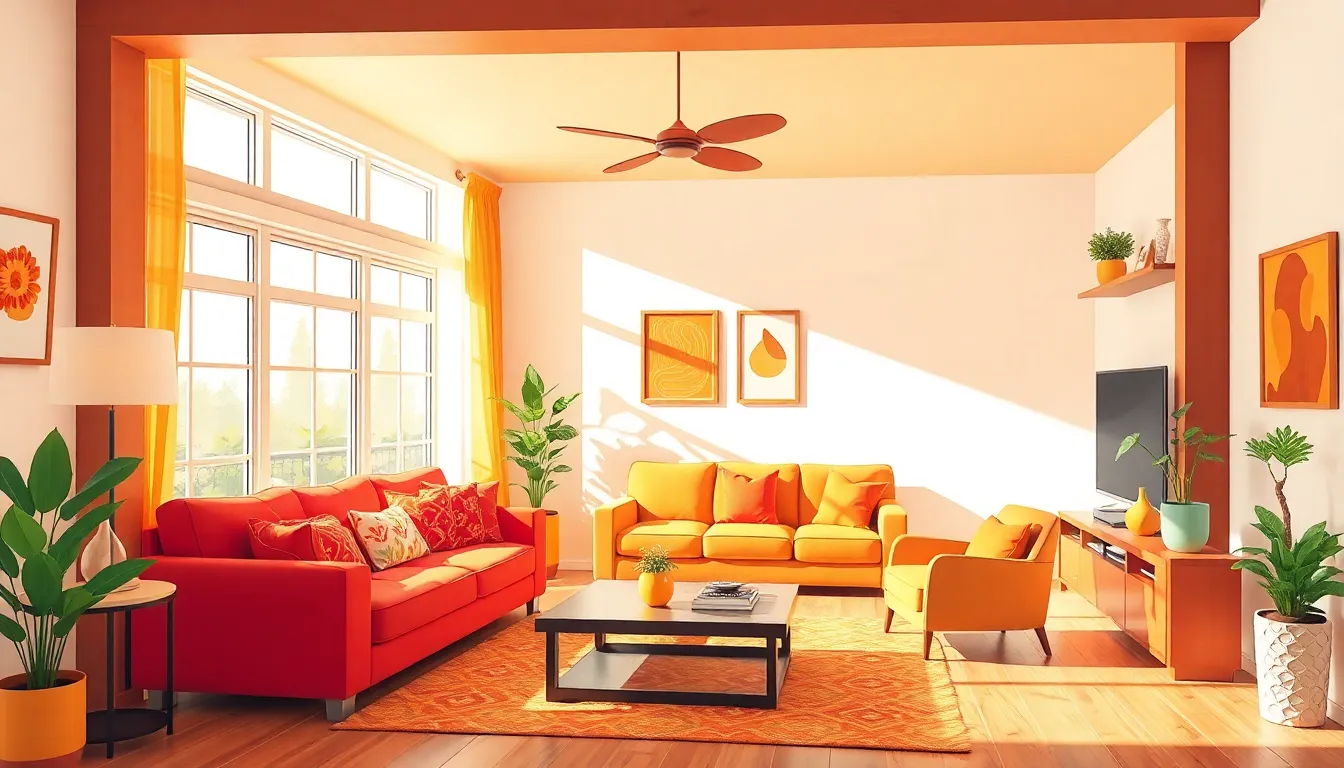Table of Contents
ToggleImagine stepping into a room that feels like a vibrant hug from your favorite rainbow. Colorful concepts in interior design do more than just please the eye; they breathe life into spaces, turning the mundane into the magnificent. It’s like giving your home a personality makeover, where every hue tells a story and every shade sparks joy.
From bold accent walls to playful furniture choices, color can transform even the dullest corners into energetic hubs of creativity. Think of it as a mood-enhancer that doesn’t come with side effects—unless you count feeling inspired as one. So grab your paintbrush and let’s dive into the colorful world of interior design, where every splash of color is a step toward a more joyful and dynamic living space.
Understanding Colorful Concepts Interior Design
Colorful concepts in interior design center on the strategic use of color to enhance living spaces. These approaches bring vibrancy and individuality to homes.
Definition and Importance
Colorful concepts in interior design emphasize the significance of color schemes. They define a space’s ambiance and influence mood. Bright hues can energize an environment, while softer tones create calmness. The importance of color extends beyond aesthetics; it shapes perceptions and feelings. A well-planned color palette invites creativity and personal expression, making each space a reflection of its inhabitants. As a result, diverse color choices transform mundane areas into inviting, dynamic rooms.
Key Principles
Several key principles govern colorful concepts in interior design. First, balance stands out as a core element; harmonious color combinations prevent overwhelming visuals. Contrast plays a vital role, allowing certain features to shine amid a colorful backdrop. Next, considering the psychology of colors enhances emotional impact; for instance, blue promotes tranquility, while red evokes excitement. Additionally, versatility among colors provides options for varying design themes, from vibrant bohemian styles to muted modern aesthetics. Lastly, experimenting with textures and patterns enhances depth, elevating the overall design experience.
Popular Color Palettes

Color palettes play a crucial role in defining the atmosphere of a space. The choice between warm and cool color schemes influences how rooms feel and function.
Warm Color Schemes
Warm color schemes feature reds, oranges, and yellows. These colors evoke feelings of energy and warmth, making spaces feel inviting. Environments painted with warm tones often appear cozier, perfect for living rooms and dining areas. Accent pieces in bold reds can inspire conversations, while soft oranges create a cheerful atmosphere. Using warm colors strategically enhances social interactions and promotes liveliness. Combining these hues with natural light amplifies their vibrancy, elevating the overall design impact.
Cool Color Schemes
Cool color schemes consist of blues, greens, and purples. These tones promote tranquility and relaxation, ideal for bedrooms and bathrooms. Spaces adorned in cool colors feel refreshing and can ease stress. Softer blues evoke a serene ambiance, while deeper shades create sophistication. Incorporating accents like teal or lavender can introduce a playful touch without overwhelming the senses. The use of cool tones in conjunction with natural textiles fosters a calming environment, transforming areas into personal retreats.
Techniques for Implementing Color
Implementing color in interior design involves various techniques that create dynamic, inviting spaces. Strategies such as accent walls and thoughtful furniture selections significantly enhance a room’s aesthetic.
Accent Walls
Accent walls serve as focal points that draw attention and infuse vibrancy. Choosing bold colors, like deep blues or rich reds, transforms walls into expressive canvases. Paint, wallpaper, or, even decorative panels offer versatility in materials. Selecting a single wall in a room maximizes impact while maintaining design balance. Incorporating textures with brick or wood combinations enhances depth and visual interest. These walls harmonize well with neutral tones in surrounding space, allowing vivid colors to shine.
Furniture and Decor Choices
Furniture selections also influence color implementation significantly. Opting for colorful furniture pieces, like bright sofas or eclectic chairs, allows for personality in living spaces. Incorporating vibrant throw pillows and blankets complements larger elements, creating visual cohesion, while coordinating colors across cushions and artworks emphasizes harmony. Accessories, such as colorful vases or wall art, contribute subtle pops of color without overwhelming the space. Choosing decor that reflects the overall color palette unifies the design, enhancing emotional impact.
Case Studies of Successful Projects
Successful integration of colorful concepts enhances interior spaces, whether residential or commercial. This section explores notable examples showcasing effective color use.
Residential Interiors
One striking example of residential interiors features a vibrant open-concept living room with teal accent walls. Colorful artwork complements the bold color choice, creating a cohesive aesthetic. In addition, bright yellow furniture brings energy, offering a cheerful focal point. The use of various textures, such as plush rugs and patterned cushions, adds depth and personality. Homeowners successfully transformed their space into a lively haven, demonstrating the emotional impact of strategic color application.
Commercial Spaces
In the realm of commercial spaces, a tech startup’s office illustrates impactful use of color. Bold orange conference rooms encourage creativity and collaboration, while serene green lounges foster relaxation. Each area uses color intentionally to influence mood and productivity. Bright murals and quirky decor enhance the energetic environment, showcasing the firm’s innovative spirit. Through thoughtful color schemes, this office design generates an inviting atmosphere, attracting talent and inspiring teamwork.
Tips for Balancing Color
Balancing color in interior design creates harmony and enhances the space’s ambiance. Attention to color selection and distribution is key for achieving this objective.
Choosing the Right Colors
Selecting colors depends on the room’s purpose and desired mood. Warm colors energize spaces, making them ideal for living areas. On the other hand, cool shades create tranquility, suitable for bedrooms. Consider existing furniture and decor, ensuring chosen colors complement these elements. Additionally, incorporating neutral colors can provide a foundation for bolder hues, enhancing impact without overwhelming the eye. A well-defined color palette appears cohesive, making transitions between shades more fluid and inviting.
Avoiding Overwhelming Aesthetics
Maintaining a balanced aesthetic prevents color overload. Limit the palette to three or four primary colors for clarity and cohesion. Use colors in varying intensities, mixing bright tones with softer shades. Distribute vibrant colors across the room for even visual interest. Choosing one or two statement pieces can draw attention without dominating the space. Keeping patterns subtle also helps avoid overwhelming visuals, allowing bold colors to shine through naturally. Strive for a harmonious blend, ensuring all elements interact without conflict or chaos.
Colorful concepts in interior design offer endless possibilities for creating vibrant and inviting spaces. By thoughtfully integrating bold hues and strategic color schemes, individuals can enhance their environments and express their unique personalities. Embracing color not only transforms a room’s aesthetic but also influences mood and emotional well-being.
With techniques like accent walls and carefully selected furniture, anyone can achieve a harmonious balance that showcases vivid colors without overwhelming the senses. The right palette can energize social areas or promote tranquility in personal retreats. Ultimately, the journey of redesigning a space with color is an opportunity for creativity and self-expression, inviting joy and inspiration into everyday life.




